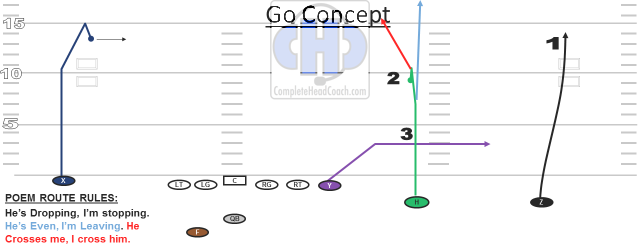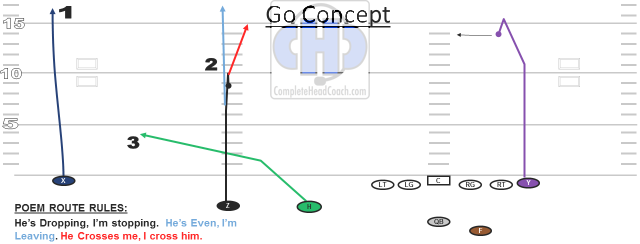The Run and Shoot is one of the most prolific, high scoring offenses of all time. You don’t really see it much anymore in its traditional form, but run and shoot passing concepts are scattered throughout all levels of football. Run and Shoot passing concepts are QB friendly and allow the receivers some options to deviate from the normal route by keying a defender. As Stewart "Red" Faught once said, "Balance? Hell, Pass!" This is the philosophy of a lot Run and Shoot teams that are still running the system.
One of the best known concepts within the Run and shoot is the Go route concept. Here is an explanation of the Go Route by Mouse Davis. It is a good watch if you have the time. My focus will be on the Go concept utilizing formations with an attached tight end and using a progression read instead of the traditional run and shoot read as explained in the Mouse Davis video above.
The Basics
The Go Concept is a 3 receiver side play. In a spread offense with an attached TE, you can get into a Trips formation one of two ways. TE Trips (Right/Left Hop) as you can see in first diagram and Right/Left Flip, which you can see in the second diagram. You can read about this Formation System here. You can also motion to the trips formations. This is how the play was run in the Run and Shoot the majority of the time. They liked to snap the ball right after the motion guy crossed number the #2 receiver on the front side. This can mess up any defensive coverage that 'Keys' the number 2 receiver for coverage assignments because the offense changes who #2 is right at the snap.
The Go Concept’s routes are fairly simple.
#1 Receiver Runs a GO route with a mandatory outside release. He is trying to take the safety off the hash. He must go outsides to widen the coverage.
#2 Receiver Runs the Seam read route which we call a poem route. He is going to run vertical to 10 while reading the safety and follow the poem rules. “Safety drops, I stop. Safety’s Even, I’m leaving. Safety crosses me, I cross him. “
#3 Receiver runs and arrow route.
Within the concept, the #2 and #3 receivers create a natural rub route. Some coaches like to have the QB snap the ball with those 2 receivers real close to each other for more of a rub and some like to create a little more distance with a wider split between the #2 and #3 receivers. It is just whatever you prefer and the tendencies of the defense you are playing against. We have run it both ways with success.
These route combinations can be seen in the diagram below.
In the flip formation, the concept would look like this:

The QB Read on the Go Concept
Traditionally the QB would have a different guy to read based upon the coverage and which defender has to cover the flat. In a Cover 2 look, the QB would read the Corner and throw off his reaction. In a cover 3 look, the QB would read the down safety or outside LB and throw off his reaction. After having our QB read the play this way for a season and missing out on some scoring opportunities, we decided to use a progression read and see if we could get more big plays. Rather than read a defender, we began using the Air Raid model of QB progression reading. This is great for vertical stretch play's like the Go route.
The QB progression became the following:
#1 – Go
#2 – Poem Route (Seam Read)
#3 – Arrow Route.
The QB really doesn't have a #4 read because we figured that he wouldn’t have time to get to a 4th read and he would be in scramble mode anyway. The great part of the progression read is it's backyard football. As my former high school coach told a room full of coaches at a clinic a few years ago when asked, "What the QB reading on this play?" He stated, "we just tell him to throw it to the open guy." That is basically what the progression read does. We teach our QB coverage, but the real focus is on the side he is throwing to and if he believes the receiver is open. Sometime's I think we coaches over coach the QB. The progression takes the tendency to over coach out of the equation.
The Key to the Progression
The key to the play is that the QB is making his first read during his 3 step drop. This times everything up and allows the QB to get to his 2nd and 3rd reads faster.
- QB decides the Go route is open, he should be throwing the ball immediately on his third step.
- QB decides the Go route is not open, then he checks down to the seam read route. If QB decides the seam player is open, he will throw him the ball.
- If not, he will check down to the arrow route.
We found this to be a very successful progression for our QB and we hit several Go route TD’s throughout the year. When the go wasn’t open, either the seam read or the arrow normally were open.
Below is some video. Clip #1 will show the check to the arrow. Clip 2 will show the Seam and clip 3 and 4 are to the Go route.
Due to the vertical stretch nature of the play, the progression read gave our QB an opportunity to take some shots and create some explosive plays for our team.
Thanks for reading.

Thanks what is a seam read ? If the seam is open continue if the seam is closed run a skinny and split the safeties or is it if he drops I stop if he’s low I go, I have seen both and also if I can step on the safeties toes I go
Coach, Thanks for the comment. I explain the seam read here Seam Read Post Basically, what you stated is the seam read. We just use a simple poem to define it.